Arabian Jasmine Plant Care: How to Grow & Care for Jasmium Sambac
Written by Iris
Nov 02 2021
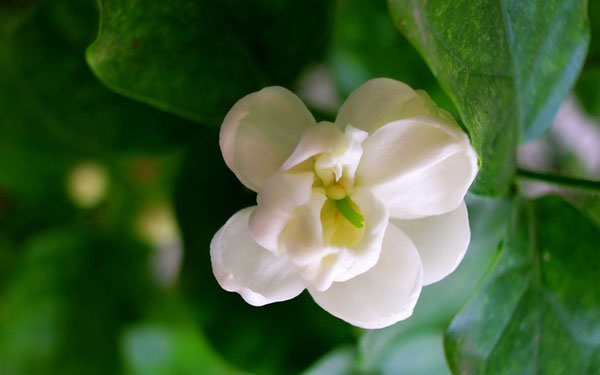
Interested in Growing and caring for Jasmine Plant? Here is Information for growing and caring for Arabian jasmine. Arabian jasmine, also called jasmine sambac, is a plant native to Asia, where trade made it popular in Arabia and Persia. Through breeding, several different types of jasmine have been produced, also known by several different names. Arabian jasmine is commonly used in perfumes and teas. It can be a garden or houseplant. It is usually grown as a medium-sized shrub, and it will grow as a vine carefully.
Arabian jasmine plants prefer mild moisture, so it is recommended to buy earthen pots that are just the right size.
If planting them on the ground, make sure to plow the land well and place the plants about 75 centimeters apart, in rows spaced 1 meter apart.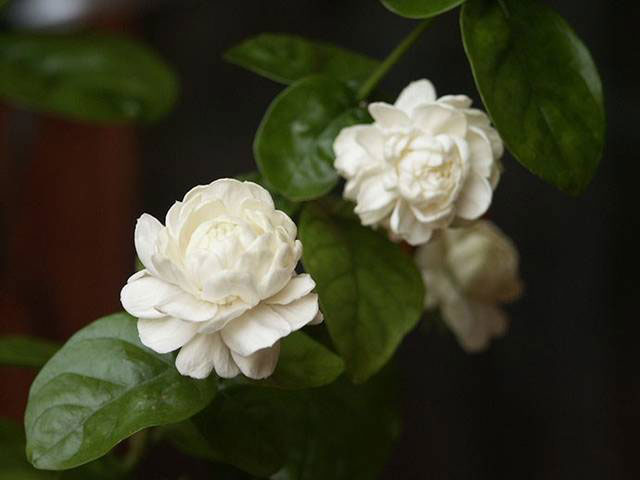
The flowering period ranges between April to May, and from August to November. However, if provided with the best conditions, these plants flourish and bloom throughout the year.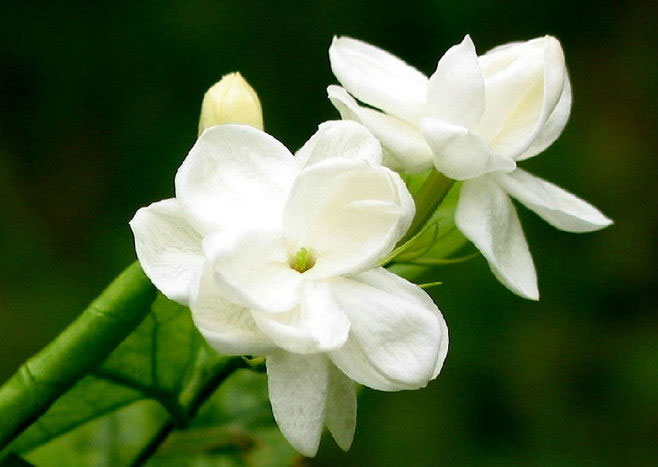
Start cutting directly below a leaf and make them 20 to 25 centimeters long, with 3-4 eyes.
Strip the leaves at the bottom of the cuttings and use rooting hormones.
Place the cuttings in a planter and cover them with a plastic bag to retain moisture.
Keep the planter out of direct sunlight.
After about a month, the roots will develop and the cuttings will be ready for transplantation. Next, depending on the roots, you can either plant them in potting soil or directly into land.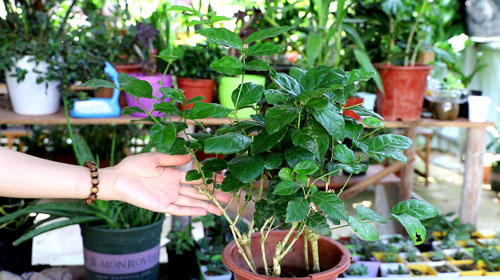
Dig a shallow hole in the ground.
Bend the branch so that the cut portion is well into the soil.
Cover it with soil, making sure that the remaining stem is above the soil. Bend the tip into a vertical position with the help of a landscaping pin or brick.
Keep the cut open with a toothpick or a small pebble. Use a rooting hormone, if required.
Keep the area moist.
Once roots develop, cut the new branch and transplant it in a pot or land, as desired. Learn more about the technique here.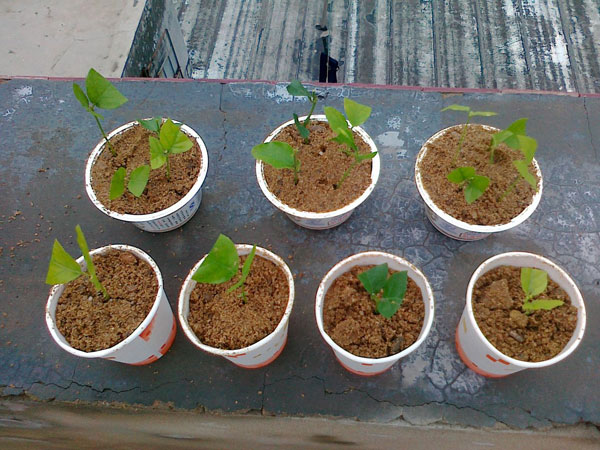
Secondly, layering requires long periods of time and depends heavily on the season.
Therefore, in recent years, tissue culture techniques have been developed for the propagation of plants that have lost the ability to bear seeds.
The process includes collecting vegetative parts like shoots, roots, leaves, etc. from mature plants and then treating them with plant growth hormones in sterile mediums. This results in the formation of a large number of identical seedlings.
The following are the required steps to cultivate Arabian Jasmine through seeds:
Start the germination process of jasmine seeds indoors about 3 months prior to your outdoor planting date.
Soak the seeds in water for 24 hours before planting.
Add seed starting mix to six containers, and soak the soil completely. Allow it to drain before planting, then plant one seed in each cell.
Cover the containers with plastic to retain moisture and place them in direct sunlight.
Keep the soil moist while the seedlings sprout.
Transplant each seedling into a gallon-sized planter, once all of them grow two pairs of true leaves.
Keep these plants indoors for at least one month after this, or grow your Arabian jasmine as a houseplant during the first year before transplanting them outdoors.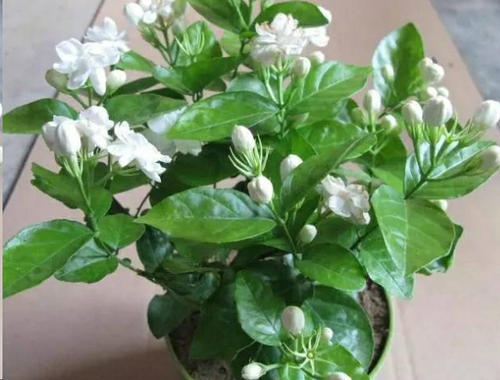
Bud worms: Small green caterpillars feed on the plant leaves and the flower petals. This results in loss of vegetation, fading of color, or ruining of the flower buds due to excreta.
Midges: Certain insects like mosquitoes and house flies lay eggs at the base of flower buds. The maggots enter the buds and feed from within, resulting in the wilting of buds.
Leaf thrips: These are seen in large numbers on the lower surface of the leaves and feed on the leaf sap and lamina. The leaves, as a result, become leathery, yellowish, and may dry off.
Stem borer: Larvae of some insects bore into the stem. This results in damaging and drying off of the affected stems, and eventually the whole branch.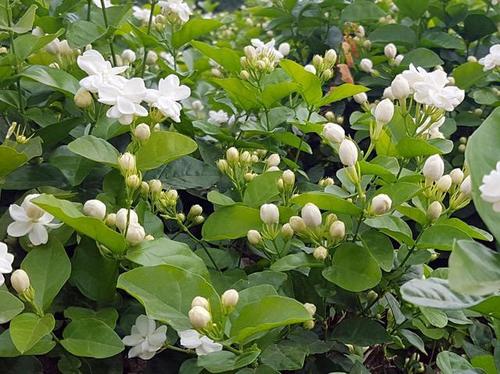
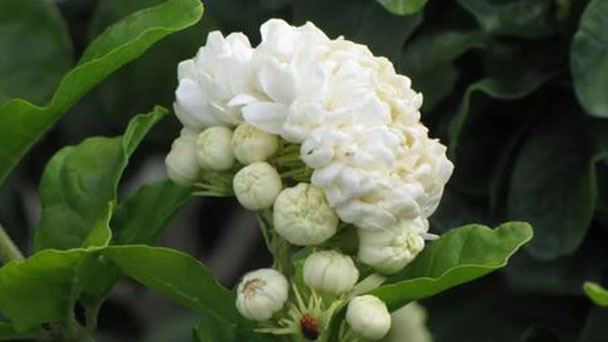
Most of the yellow and fragrant white arabian jasmine flowers are one of the best deciduous vines to decorate winter gardens.
Jasmine's fragrance has also made a huge contribution to the synthetic fragrance industry: hundreds of floral fragrances have been discovered from jasmine's aroma components or chemists have created them by mimicking jasmine's fragrance, the most "colorful" of all floral fragrances. Many valuable new spices were first found in Arabian Jasmine oil.
According to the unique adsorption properties of tea leaves and the spouting characteristics of Arabian Jasmine, jasmine tea is processed through a series of technological processes, which not only keeps the strong and refreshing taste of green tea, but also contains the fresh fragrance of Arabian Jasmine.
Arabian Jasmine Quick InfoWhere to Grow Arabian JasmineWhen to Grow Arabian JasmineHow to Propagate Arabian JasmineArabian Jasmine Cutting PropagationArabian Jasmine Layering PropagationArabian Jasmine Tissue Culture PropagationArabian Jasmine Seed PropagationHow to Care for Arabian JasmineArabian Jasmine Lighting RequirementsArabian Jasmine Soil CareArabian Jasmine WateringArabian Jasmine Temperature & Humidity CareArabian Jasmine Fertilizer CareArabian Jasmine Pests & Diseases CareVarieties of Arabian JasmineArabian Jasmine BenefitsGarden UsesEconomic ValuesEdiblenessMedical Uses
Arabian Jasmine Quick Info
Arabian jasmine is an upright or climbing shrub, reaching a height of 3 m. Branchlets are terete or slightly compressed, sometimes hollow, sparsely pilose. Arabian jasmine is a terminal cyme, usually with 3 flowers, sometimes as many as 5 single flowers. The white flowers are very fragrant, so it is commonly used in perfumes and teas.| Botanical/Scientific Name | Jasminum sambac |
| Common Name | Arabian Jasmine, Mohle Flower, White-Flowered Indian Jasmine, Zambac, Sampa Gita |
| Plant Type | Climbers, Shrubs, Evergreen |
| Light Requirements | Full sun to partial shade. Full sun is best for flowering. |
| Soil Requirements | Loam, moist but well-drained soil |
| Bloom Time | Summer |
| Flower Color | White, pink flower |
| Uses | Container flower, used in perfumes, teas and medicines |
Where to Grow Arabian Jasmine
Choosing the right pots is just as important as every other step in the process.Arabian jasmine plants prefer mild moisture, so it is recommended to buy earthen pots that are just the right size.
If planting them on the ground, make sure to plow the land well and place the plants about 75 centimeters apart, in rows spaced 1 meter apart.

When to Grow Arabian Jasmine
The most appropriate time for the plantation of arabian jasmine is during the monsoons/rainy season. The plants’ first proper flowering season is observed after around a year of planting.The flowering period ranges between April to May, and from August to November. However, if provided with the best conditions, these plants flourish and bloom throughout the year.

How to Propagate Arabian Jasmine
Arabian Jasmine plants can be grown by vegetative propagation methods, which generally include cutting and ground layering.Arabian Jasmine Cutting Propagation
Start by making cuttings of stem tips from a healthy plant.Start cutting directly below a leaf and make them 20 to 25 centimeters long, with 3-4 eyes.
Strip the leaves at the bottom of the cuttings and use rooting hormones.
Place the cuttings in a planter and cover them with a plastic bag to retain moisture.
Keep the planter out of direct sunlight.
After about a month, the roots will develop and the cuttings will be ready for transplantation. Next, depending on the roots, you can either plant them in potting soil or directly into land.

Arabian Jasmine Layering Propagation
Make a 1.25 – 1.75 centimeters cut through the stem, about 7 – 12 centimeters from the tip.Dig a shallow hole in the ground.
Bend the branch so that the cut portion is well into the soil.
Cover it with soil, making sure that the remaining stem is above the soil. Bend the tip into a vertical position with the help of a landscaping pin or brick.
Keep the cut open with a toothpick or a small pebble. Use a rooting hormone, if required.
Keep the area moist.
Once roots develop, cut the new branch and transplant it in a pot or land, as desired. Learn more about the technique here.

Arabian Jasmine Tissue Culture Propagation
The above two methods, based on the principle of vegetative propagation, have certain limitations. Firstly, overuse of these methods has led to several genetic disorders in plants, like varietal degeneration, acquired resistance against these methods, formation of weak stems/roots, and decreased flowering.Secondly, layering requires long periods of time and depends heavily on the season.
Therefore, in recent years, tissue culture techniques have been developed for the propagation of plants that have lost the ability to bear seeds.
The process includes collecting vegetative parts like shoots, roots, leaves, etc. from mature plants and then treating them with plant growth hormones in sterile mediums. This results in the formation of a large number of identical seedlings.
Arabian Jasmine Seed Propagation
Arabian Jasmine is originally a non-seed bearing plant. However, depending on the genotype and surrounding environment, seed setting and seed germination can be seen, albeit rarely.The following are the required steps to cultivate Arabian Jasmine through seeds:
Start the germination process of jasmine seeds indoors about 3 months prior to your outdoor planting date.
Soak the seeds in water for 24 hours before planting.
Add seed starting mix to six containers, and soak the soil completely. Allow it to drain before planting, then plant one seed in each cell.
Cover the containers with plastic to retain moisture and place them in direct sunlight.
Keep the soil moist while the seedlings sprout.
Transplant each seedling into a gallon-sized planter, once all of them grow two pairs of true leaves.
Keep these plants indoors for at least one month after this, or grow your Arabian jasmine as a houseplant during the first year before transplanting them outdoors.

How to Care for Arabian Jasmine
Arabian Jasmine (Jasmine sambac) prefers warm and moist, and grows best in a well-ventilated, semi-cloudy environment. Soil with a lot of humus in the slightly acidic sandy soil is the most suitable. Most varieties of Arabian Jasmine are cold and drought-tolerant, and are not tolerant to frost, wet waterlogging and alkaline soil. When the temperature is lower than 3℃ in winter, branches and leaves are vulnerable to freezing damage, and they will die if they last for a long time. Deciduous lianas, on the other hand, are hardy to cold and drought.Arabian Jasmine Lighting Requirements
Full to partial sun is needed for healthy Arabian jasmine plants. At least 6 to 8 hours of sunlight per day is ideal. If kept indoors during the winter, be sure to place this plant in a very sunny window.Arabian Jasmine Soil Care
Loose, loamy, humusy soil is preferred by this flowering shrub. It likes an evenly moist, well-draining soil medium. Adding compost will help loosen, enrich, and moisten the soil.Arabian Jasmine Watering
Watering Arabian jasmine plants is necessary in the flowering season. Other than that, these plants are irrigated only if the soil moisture is inadequate. These plants cannot stand waterlogging and would be damaged in excess of water. Hence, they are watered moderately. After the flowering season is over, the watering is stopped.Arabian Jasmine Temperature & Humidity Care
Arabian jasmine thrives in warm, tropical climates from USDA hardiness zones 9 to 12. They are very susceptible to frost and cannot handle cold temperatures. Because they are tropical plants, Arabian jasmine needs moderate to high humidity levels.Arabian Jasmine Fertilizer Care
Arabian jasmine plants require 15-30 kilograms of Farm Yard Manure (FYM), 60-120 grams of Nitrogen content, 120-240 grams of Phosphorus content, and 120-240 grams of Potassium content per year, which should be given in 3 to 4 split doses. After manuring, watering is resumed.Arabian Jasmine Pests & Diseases Care
Though arabian jasmine plants show resistance to most pests and mites, sometimes they are harmed by certain pests.Bud worms: Small green caterpillars feed on the plant leaves and the flower petals. This results in loss of vegetation, fading of color, or ruining of the flower buds due to excreta.
Midges: Certain insects like mosquitoes and house flies lay eggs at the base of flower buds. The maggots enter the buds and feed from within, resulting in the wilting of buds.
Leaf thrips: These are seen in large numbers on the lower surface of the leaves and feed on the leaf sap and lamina. The leaves, as a result, become leathery, yellowish, and may dry off.
Stem borer: Larvae of some insects bore into the stem. This results in damaging and drying off of the affected stems, and eventually the whole branch.

Varieties of Arabian Jasmine
- Common jasmine (Jasminum officinale)
-
Showy jasmine
-
Spanish jasmine (J. grandiflorum)
-
Jasminum Sambac (Arabian Jasmine)

Arabian Jasmine Benefits
Arabian Jasmine is one of the most popular flowers with light fragrance floating everywhere, which is very pleasant. It is not toxic and is suitable to grow as house plants. Many popular flowers have positive benefits, and Arabian Jasmine is no exception.Garden Uses
Evergreen small Arabian Jasmine shrubs are green, white in color and strong in fragrance. It is a common garden and potted ornamental fragrant flower. Arabian Jasmine can be processed into garlands and other decorationsMost of the yellow and fragrant white arabian jasmine flowers are one of the best deciduous vines to decorate winter gardens.
Economic Values
Arabian Jasmine flower can extract jasmine oil, which is the essence raw materials. Arabian Jasmine can also replace rose dew as a fumigating tea spice production.Jasmine's fragrance has also made a huge contribution to the synthetic fragrance industry: hundreds of floral fragrances have been discovered from jasmine's aroma components or chemists have created them by mimicking jasmine's fragrance, the most "colorful" of all floral fragrances. Many valuable new spices were first found in Arabian Jasmine oil.
Edibleness
Arabian Jasmine tea has the function of dispelling cold evil and assisting depression, and is the top quality tea in spring. Tea contains a lot of healthy compounds, such as catechin, vitamin C, A, caffeine, flavanols, tea polyphenols, and jasmine tea also contains a large number of aromatic oil, geraniol, orange zanthol alcohol, syringyl ester and other more than 20 compounds.According to the unique adsorption properties of tea leaves and the spouting characteristics of Arabian Jasmine, jasmine tea is processed through a series of technological processes, which not only keeps the strong and refreshing taste of green tea, but also contains the fresh fragrance of Arabian Jasmine.
Medical Uses
Arabian Jasmine flowers, leaves and roots can be used for medicinal purposes. Generally, dig the roots after autumn, slice them and dry them in the sun. Pick flowers in summer and autumn and dry them.Latest Updated
- Benefits of Bugleweed - 7 Science-backed Health Benefits
- Bugleweed Dangers & Side Effects - Is It Poisonous?
- How to Plant Evergreen Trees - What You Should Know
- When to Plant Evergreens - Grow Guide for Evergreen Trees
- 12 Wonderful Evergreen Shrubs for Your Garden
- 12 Popular Evergreen Plants with Pictures for Beginners
- When And How To Prune A Lilac Bush Like a Pro
- How to Grow & Care for Lilac Vine (Hardenbergia Violacea)
- Japanese Lilac Tree (Syringa Reticulata) Care & Propagation Guide
- Shumard Oak Pros and Cons - What to Know
Popular Articles
- Winter maintenance of Antirrhinum Majus
- How to Grow Terminalia Mantaly Tree
- How to Grow and Care for Crossostephium Chinense
- How to grow Antirrhinum Majus in spring
- Peristeria Elata (Dove Orchid) Profile: Info & Care Guide
- Underwatered Snake Plant (Sansevieria Trifasciata) - Signs And How To Fix
- How to Care for Brazilian Jasmine Plant (Mandevilla Sanderi)
- How to Grow & Care for Graptopetalum Purple Delight in Summer
- Rosa Chinensis (China Rose): Plant Growing & Care Tips
- How to Care for Baby Sun Rose (Aptenia Cordifolia)